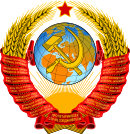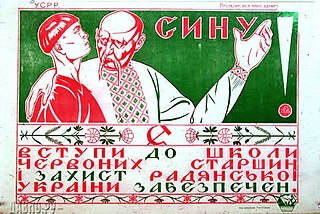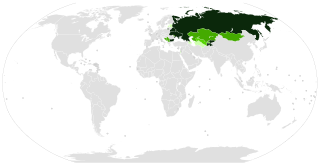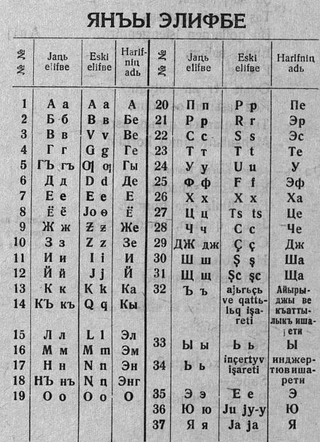| Language Family | Language | Official in | Distribution | Status [6] |
|---|
| Indo-European > Slavic > East Slavic | Russian |  Soviet Union Soviet Union  Russian SFSR Russian SFSR
| Spoken in all republics | Safe |
| Ukrainian |  Ukrainian SSR Ukrainian SSR | Ukrainian SSR, Russian SSR, Byelorussian SSR, Estonian SSR, Moldavian SSR, Georgian SSR | Safe |
| Belarusian |  Byelorussian SSR Byelorussian SSR | Byelorussian SSR, Russian SSR, Ukrainian SSR, Latvian SSR, Lithuanian SSR | Potentially Vulnerable |
| Rusyn | | Ukrainian SSR | Endangered/Unsafe |
| Indo-European > Slavic > West Slavic | Polish | | Ukrainian SSR, Byelorussian SSR, Estonian SSR | |
| Slovak | | Ukrainian SSR, Byelorussian SSR, Georgian SSR | Potentially Vulnerable |
| Indo-European > Slavic > South Slavic | Bulgarian | | Ukrainian SSR, Moldavian SSR | Potentially Vulnerable |
| Indo-European > Baltic | Latvian |  Latvian SSR Latvian SSR | Latvian SSR | Safe |
| Latgalian | | Latvian SSR | Potentially Vulnerable |
| Lithuanian |  Lithuanian SSR Lithuanian SSR | Lithuanian SSR | Safe |
| Indo-European > Germanic > North Germanic | Norwegian | | Russian SSR | |
| Swedish | | Estonian SSR, Ukrainian SSR | (Estonian Swedish) Critically Endangered |
| Indo-European > Germanic > West Germanic | German | Volga German ASSR | Russian SSR, Ukrainian SSR, Estonian SSR, Kazakh SSR | |
| Indo-European > Germanic > West Germanic > High German | Yiddish |  Jewish AO Jewish AO | Russian SSR, Ukrainian SSR, Byelorussian SSR | Potentially Vulnerable |
| Indo-European > Germanic > West Germanic > North Sea Germanic | Plautdietsch | | Kazakh SSR | |
| Indo-European > Romance > Romanian | Moldovan (Romanian) | Moldavian ASSR  Moldavian SSR Moldavian SSR
| Moldavian SSR, Ukrainian SSR | Safe |
| Indo-European > Romance > Italo-Western | Italian | | Ukrainian SSR | |
| Indo-European > Albanian | Albanian | | Ukrainian SSR | |
| Indo-European > Hellenic > Attic-Ionic | Pontic Greek | | Russian SSR, Ukrainian SSR, Georgian SSR, Armenian SSR, Kazakh SSR | Definitely Endangered |
| Indo-European > Armenian | Eastern Armenian |  Armenian SSR Armenian SSR Nagorno-Karabakh AO | Armenian SSR | Safe |
| Western Armenian | | Armenian SSR | Potentially Vulnerable |
| Indo-European > Armenian & Romani | Lomavren | | Armenian SSR | Critically Endangered |
| Indo-European > Indo-Aryan > Romani | Baltic Romani | | Russian SSR, Byelorussian SSR, Ukrainian SSR, Estonian SSR, Latvian SSR, Lithuanian SSR | Endangered/Unsafe |
| Sinte Romani | | Kazakh SSR | |
| Northern Vlax Romani | | Ukrainian SSR, Moldovian SSR | Potentially Vulnerable |
| Northern Balkan Romani | | Ukrainian SSR, Moldovian SSR | Potentially Vulnerable |
| Southern Central Romani | | Ukrainian SSR | Potentially Vulnerable |
| Indo-European > Indo-Aryan | Parya | | Tajik SSR, Uzbek SSR | Definitely Endangered |
| Indo-European > Iranian > West Iranian | Tajik |  Tajik SSR Tajik SSR | Tajik SSR | Potentially Vulnerable |
| Bukharian Dialect (Judeo-Tajik) | | Tajik SSR, Uzbek SSR | Definitely Endangered |
| Kurmanji (Northern Kurdish) | | Azerbaijan SSR, Russian SSR, Armenian SSR, Georgian SSR, | Definitely Endangered |
| Tat | Dagestan ASSR | Azerbaijan SSR, Russian SSR | Severely Endangered |
| Juhuri (Judeo-Tat) | | Azerbaijan SSR, Russian SSR | Endangered/Unsafe |
| Talysh | | Azerbaijan SSR | Potentially Vulnerable |
| Indo-European > Iranian > East Iranian > Scythian | Ossetian | North Ossetian ASSR South Ossetian AO | Georgian SSR, Russian SSR | Endangered/Unsafe |
| Yaghnobi | | Tajik SSR | Endangered/Unsafe |
| Indo-European > Iranian > East Iranian > Scythian/Pamiri | Wakhi | | Tajik SSR | Endangered/Unsafe |
| Indo-European > Iranian > East Iranian > Pamiri | Rushani | | Tajik SSR | Endangered/Unsafe |
| Shughni | | Tajik SSR | Endangered/Unsafe |
| Yazghulami | | Tajik SSR | Endangered/Unsafe |
| Bartangi | | Tajik SSR | Endangered/Unsafe |
| Ishkashimi | | Tajik SSR | Endangered/Unsafe |
| Khufi | | Tajik SSR | Endangered/Unsafe |
| Sanglechi | | Tajik SSR | Endangered/Unsafe |
| Kartvelian | Georgian |  Georgian SSR Georgian SSR | Georgian SSR | Safe |
| Kivruli/Gruzinic Dialect (Judeo-Georgian) | | Georgian SSR | Endangered/Unsafe |
| Svan | | Georgian SSR, Russian SSR | Endangered/Unsafe |
| Mingrelian | | Georgian SSR, Russian SSR | Definitely Endangered |
| Laz | | Georgian SSR | Endangered/Unsafe |
| Northwest Caucasian | Abkhaz |  Abkhaz ASSR Abkhaz ASSR | Georgian SSR | Potentially Vulnerable |
| Abaza | | Russian SSR | Endangered/Unsafe |
| Kabardian (East Circassian) | Kabardino-Balkarian ASSR Karachay-Cherkess AO | Russian SSR | Potentially Vulnerable |
| Adyghe (West Circassian) | | Russian SSR | Endangered/Unsafe |
| Ubykh | | Russian SSR | Extinct |
| Northeast Caucasian > Nakh | Chechen | Checheno-Ingush ASSR Dagestan ASSR | Russian SSR, Azerbaijan SSR, Ukrainian SSR, Kirghiz SSR, Kazakh SSR, Georgian SSR | Potentially Vulnerable |
| Ingush | Checheno-Ingush ASSR | Russian SSR, Kazakh SSR, Uzbek SSR, Turkmen SSR | Potentially Vulnerable |
| Bats | | Georgian SSR | Severely Endangered |
| Northeast Caucasian > Avar-Andic | Avar | Dagestan ASSR | Russian SSR, Ukrainian SSR, Georgian SSR, Azerbaijan SSR, Kazakh SSR | Potentially Vulnerable |
| Andi | | Russian SSR | Endangered/Unsafe |
| Tindi | | Russian SSR | Definitely Endangered |
| Bagvalal | | Russian SSR | Definitely Endangered |
| Akhvakh | | Russian SSR, Azerbaijan SSR | Definitely Endangered |
| Karata-Tukita | | Russian SSR | Definitely Endangered |
| Botlikh | | Russian SSR | Definitely Endangered |
| Godoberi | | Russian SSR | Definitely Endangered |
| Chamalal | | Russian SSR | Definitely Endangered |
| Northeast Caucasian > Dargin | Dargwa | Dagestan ASSR | Russian SSR | Potentially Vulnerable |
| Kaitag | | Russian SSR | |
| Kubachi | | Russian SSR | |
| Itsari | | Russian SSR | |
| Chirag | | Russian SSR | Severely Endangered |
| Northeast Caucasian > Khinalug | Khinalug | | Azerbaijan SSR | Definitely Endangered |
| Northeast Caucasian > Lak | Lak | Dagestan ASSR | Russian SSR | Potentially Vulnerable |
| Northeast Caucasian > Lezgic | Archi | | Russian SSR | Definitely Endangered |
| Lezgian | Dagestan ASSR | Russian SSR, Azerbaijan SSR | Potentially Vulnerable |
| Tabasaran | Dagestan ASSR | Russian SSR, Ukrainian SSR | Potentially Vulnerable |
| Aghul | | Russian SSR, Azerbaijan SSR | Definitely Endangered |
| Rutul | | Russian SSR, Azerbaijan SSR | Endangered/Unsafe |
| Tsakhur | | Russian SSR, Azerbaijan SSR | Endangered/Unsafe |
| Udi | | Russian SSR, Azerbaijan SSR, Georgian SSR | Definitely Endangered |
| Kryts | | Azerbaijan SSR | |
| Jek | | Azerbaijan SSR | |
| Budukh | | Azerbaijan SSR | Definitely Endangered |
| Northeast Caucasian > Tsezic | Tsez | | Russian SSR | Definitely Endangered |
| Bezhta | | Russian SSR | Definitely Endangered |
| Hunzib | | Russian SSR, Georgian SSR | Definitely Endangered |
| Khwarshi | | Russian SSR | Definitely Endangered |
| Hinuq | | Russian SSR | Definitely Endangered |
| Uralic > Balto-Finnic | Estonian |  Estonian SSR Estonian SSR | Estonian SSR | Safe |
| Võro | | Estonian SSR | Endangered/Unsafe |
| Seto Dialect | | Estonian SSR | |
| Karelian |  Karelo-Finnish SSR Karelo-Finnish SSR | Karelo-Finnish SSR, Russian SSR | Definitely Endangered |
| Finnish |  Karelo-Finnish SSR Karelo-Finnish SSR | Karelo-Finnish SSR, Russian SSR | Safe |
| Ingrian | | Russian SSR, Karelo-Finnish SSR, Byelorussian SSR, Ukrainian SSR, Estonian SSR, Kazakh SSR | Severely Endangered |
| Ludic | | Karelo-Finnish SSR, Russian SSR | |
| Votic | | Karelo-Finnish SSR, Russian SSR | Critically Endangered |
| Livonian | | Latvian SSR | Critically Endangered |
| Veps | | Karelo-Finnish SSR, Russian SSR | Severely Endangered |
| Uralic > Sámi | Kildin Sámi | | Russian SSR | Severely Endangered |
| Ter Sámi | | Russian SSR | Critically Endangered |
| Skolt Sámi | | Russian SSR | Critically Endangered |
| Akkala Sámi | | Russian SSR | Extinct |
| Uralic > Permic | Komi-Zyrian | Komi ASSR | Russian SSR | Potentially Vulnerable |
| Komi-Permyak | Komi-Permyak Autonomous Okrug | Russian SSR | Endangered/Unsafe |
| Komi-Yazva | | Russian SSR | Severely Endangered |
| Udmurt | Udmurt ASSR | Russian SSR, Ukrainian SSR, Estonian SSR, Latvian SSR, Kazakh SSR | Definitely Endangered |
| Mari | Mari ASSR | Russian SSR | Potentially Vulnerable |
| Uralic > Mordvinic | Erzya | Mordovian ASSR | Russian SSR | Definitely Endangered |
| Moksha | Mordovian ASSR | Russian SSR | Endangered/Unsafe |
| Uralic > Samoyedic | Tundra Nenets | Nenets AO Yamalo-Nenets AO | Russian SSR | Definitely Endangered |
| Forrest Nenets | | Russian SSR | Severely Endangered |
| Enets | | Russian SSR | Critically Endangered |
| Selkup | | Russian SSR | Definitely Endangered |
| Nganasan | | Russian SSR | Severely Endangered |
| Kamassian | | Russian SSR | Extinct |
| Uralic > Ugric > Khanty | Salekhard (Northern) Khanty | | Russian SSR | Severely Endangered |
| Surgut(Eastern) Khanty | | Russian SSR | Critically Endangered |
| Southern Khanty | | Russian SSR | Extinct |
| Uralic > Ugric > Mansi | Central Mansi | | Russian SSR | Severely Endangered |
| Northern Mansi | | Russian SSR | Definitely Endangered |
| Southern Mansi | | Russian SSR | Extinct |
| Uralic > Ugric | Hungarian | | Ukrainian SSR | Safe |
| Turkic > Oghuric | Chuvash | Chuvash ASSR | Russian SSR | Potentially Vulnerable |
| Turkic > Kipchak | Kazakh |  Kazakh SSR Kazakh SSR | Kazakh SSR | Potentially Vulnerable |
| Kyrgyz |  Kirghiz SSR Kirghiz SSR | Kirghiz SSR | |
| Tatar |  Tatar ASSR Tatar ASSR | Russian SSR, Byelorussian SSR, Ukrainian SSR, Kazakh SSR, Kirghiz SSR | Potentially Vulnerable |
| Crimean Tatar |  Crimean ASSR Crimean ASSR | Russian SSR, Byelorussian SSR, Ukrainian SSR, Lithuanian SSR, Uzbek SSR, Kirghiz SSR | Severely Endangered |
| Dobrujan Tatar | | Ukrainian SSR, Moldavian SSR | |
| Siberian Tatar | | Russian SSR | Endangered/Unsafe |
| Bashkir |  Bashkir ASSR Bashkir ASSR | Russian SSR | Potentially Vulnerable |
| Urum | | Ukrainian SSR, Georgian SSR | Definitely Endangered |
| Krymchak | | Russian SSR, Ukrainian SSR | Critically Endangered |
| Karaim | | Russian SSR, Ukrainian SSR, Lithuanian SSR | Critically Endangered |
| Nogai | Dagestan ASSR Karachay-Cherkess AO | Russian SSR, Ukrainian SSR, Kazakh SSR, Uzbek SSR | Definitely Endangered |
| Kumyk | Dagestan ASSR | Russian SSR, Ukrainian SSR, Byelorussian SSR, Latvian SSR, Kazakh SSR, Uzbek SSR | Potentially Vulnerable |
| Karachay-Balkar | Kabardino-Balkarian ASSR Karachay-Cherkess AO | Russian SSR | Potentially Vulnerable |
| Karakalpak |  Karakalpak ASSR Karakalpak ASSR | Kazakh SSR, Uzbek SSR, Turkmen SSR | Potentially Vulnerable |
| Southern Altai | | Russian SSR | Definitely Endangered |
| Fergana | | Uzbek SSR, Kirghiz SSR, Tajik SSR | Extinct |
| Turkic > Karluk | Uzbek |  Uzbek SSR Uzbek SSR | Uzbek SSR | Safe |
| Uighur | | Uzbek SSR, Kirghiz SSR, Tajik SSR | Potentially Vulnerable |
| Ili Turki | | Kazakh SSR | Critically Endangered |
| Chagatai | | | |
| Turkic > Oghuz | Turkmen |  Turkmen SSR Turkmen SSR | Turkmen SSR | Potentially Vulnerable |
| Azerbaijani | Dagestan ASSR | Azerbaijan SSR | Potentially Vulnerable |
| Meskhetian Dialect (Turkish) | | Russian SSR, Ukrainian SSR, Georgian SSR, Azerbaijan SSR, Kazakh SSR, Uzbek SSR, Kirghiz SSR | |
| Gagauz | | Moldavian SSR, Ukrainian SSR | Potentially Vulnerable |
| Turkic > Siberian Turkic | Northern Altai | | Russian SSR | Definitely Endangered |
| Khakas | Khakas AO | Russian SSR | Definitely Endangered |
| Tuvan |  Tuvan ASSR Tuvan ASSR | Russian SSR | |
| Shor | | Russian SSR | Severely Endangered |
| Yakut | Yakut ASSR | Russian SSR | |
| Dolgan | | Russian SSR | Definitely Endangered |
| Chulym | | Russian SSR | Severely Endangered |
| Tofa | | Russian SSR | |
| Soyot | | Russian SSR | |
| Afro-Asiatic > Semitic | Central Asian Arabic | | Uzbek SSR, Tajik SSR | Definitely Endangered |
| Neo-Aramaic | | Armenian SSR, Georgian SSR, Azerbaijan SSR | Safe |
| Mongolic | Buryat |  Buryat ASSR Buryat ASSR | Russian SSR | |
| Kalmyk |  Kalmyk ASSR Kalmyk ASSR | Russian SSR | Definitely Endangered |
| Oirat | | Kirghiz SSR | |
| Khamnigan Mongol | | Russian SSR | |
| Mongolian | | Russian SSR | Potentially Vulnerable |
| Tungusic | Evenki | | Russian SSR | Definitely Endangered |
| Even | | Russian SSR | Severely Endangered |
| Nanai | | Russian SSR | Definitely Endangered |
| Negidal | | Russian SSR | Severely Endangered |
| Kili | | Russian SSR | Severely Endangered |
| Oroch | | Russian SSR | Severely Endangered |
| Udege | | Russian SSR | |
| Uilta | | Russian SSR | |
| Ulch | | Russian SSR | Critically Endangered |
| Chukotko-Kamchatkan | Chukchi | Chukotka AO | Russian SSR | Definitely Endangered |
| Koryak | | Russian SSR | Definitely Endangered |
| Alyutor | | Russian SSR | Critically Endangered |
| Kerek | | Russian SSR | Extinct |
| Itelmen | | Russian SSR | Severely Endangered |
| Language Isolate | Nivkh | | Russian SSR | Severely Endangered |
| Yukaghir | Tundra Yukaghir | | Russian SSR | Critically Endangered |
| Southern Yukaghir | | Russian SSR | Critically Endangered |
| Inuit-Aleut | Siberian Yupik | | Russian SSR | Definitely Endangered |
| Aleut | | Russian SSR | Definitely Endangered |
| Naukan | | Russian SSR | Definitely Endangered |
| Old Sirenik | | Russian SSR | Extinct |
| Yeniseian | Ket | | Russian SSR | Definitely Endangered |
| Language Isolate | Ainu | | Russian SSR | Extinct in Russia, Critically Endangered in Japan |
| Sino-Tibetan | Dungan | | Russian SSR, Kazakh SSR, Uzbek SSR | Endangered/Unsafe |
| Taz Dialect (Mandarin) | | Russian SSR | Extinct |
| Koreanic | Koryo-Mar | | Uzbek SSR, Kazakh SSR, Turkmen SSR, Russian SSR, Ukrainian SSR | |














